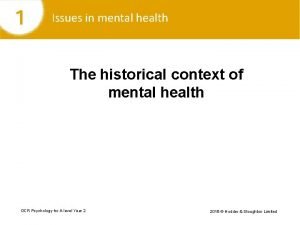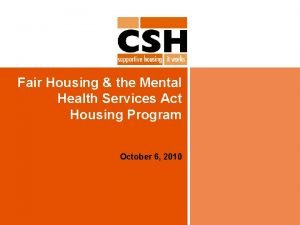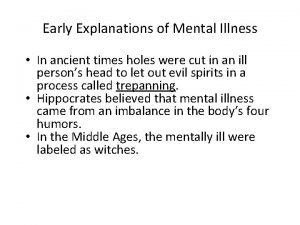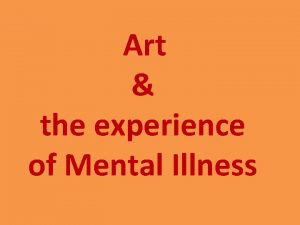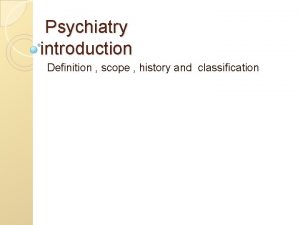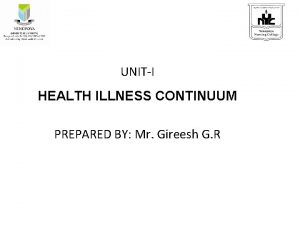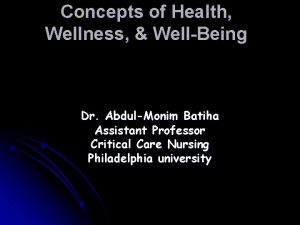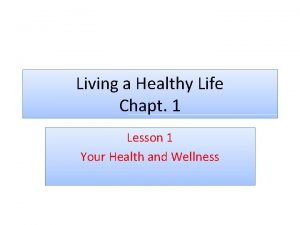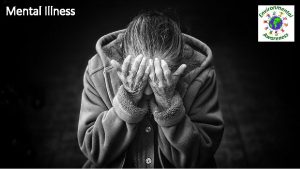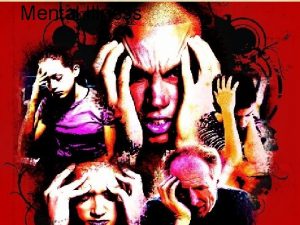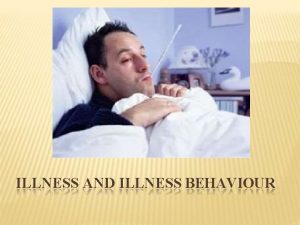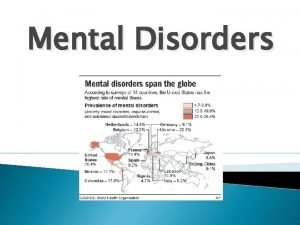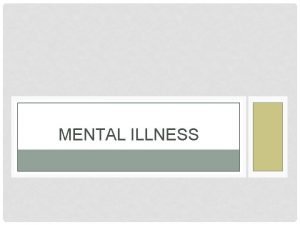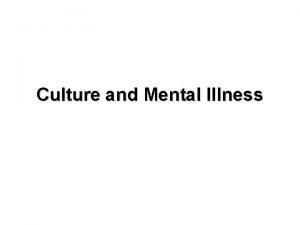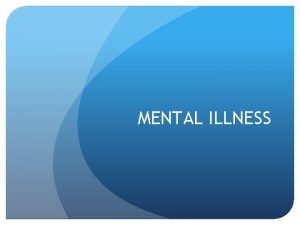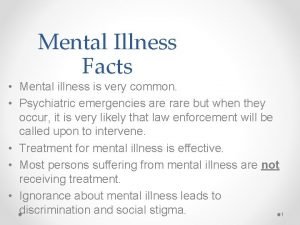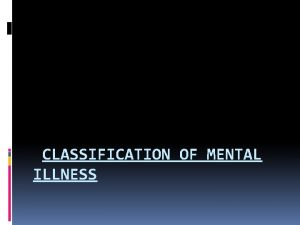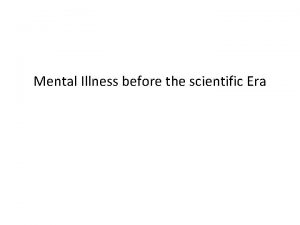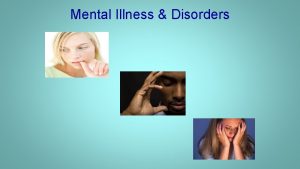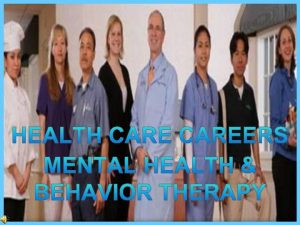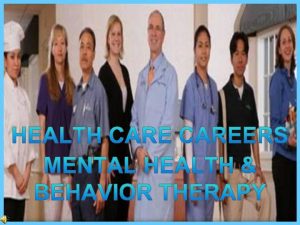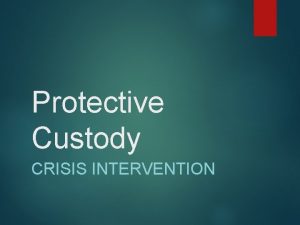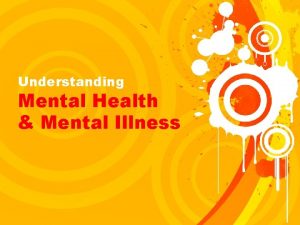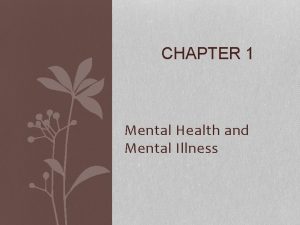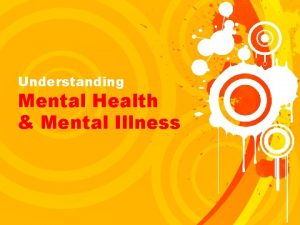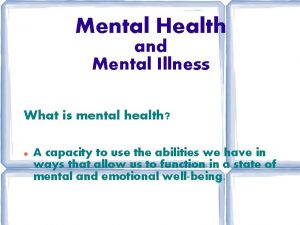MENTAL HEALTH MENTAL ILLNESS What do the following
























- Slides: 24

MENTAL HEALTH & MENTAL ILLNESS

What do the following people have in common? l l l l Abraham Lincoln (16 th US President) Virginia Wolf (Novelist) Ludwig Van Beethoven (Composer) Vincent Van Gogh (Artist) Isaac Newton (Scientist) Earnest Hemingway (Novelist) Charles Dickens (Author) Kurt Kobain (Musician) John Nash (Mathemetician) Eduard Einstein (Albert E. ’s Son) Vaclav Nijinsky (Russian Dancer) Jane Pauley (NBC Broadcaster) Michael Jackson (Musician) Linda Hamilton (Actor) Carrie Fisher (Actor) Brooke Shields (Actor) l l l Howie Mandel (Comedian) Donald Trump (Developer) Cameron Diaz (Actor) Charlie Sheen (Actor) Jessica Alba (Actor) David Beckham (Soccer Player) Jim Carrey (Actor) Tom Cruise (Actor) Steven Spielberg (Director) Bill Gates (Microsoft Creator) George Bush (Past US President) Robin Williams (Comedian)

NORMAL VS ABNORMAL

WHAT IS THE DIFFERENCE BETWEEN SOMEONE WHO IS EXPERIENCING SYMPTOMS OF A MENTAL ILLNESS AND SOMEONE WHO HAS A MENTAL ILLNESS? E. G. Someone feeling depressed and someone diagnosed with depression.

FACT OR FICTION?

One person in 100 develops schizophrenia. TRUE. One per cent of the general population develops schizophrenia

A person who has 1 or 2 parents with mental illness is more likely to develop mental illness. TRUE. Mental illness can be hereditary. For example, the rate of schizophrenia in the general population is one per cent. This rate rises to eight per cent if one parent has the disorder and the 37 -46 per cent if both parents have it. 1 in 10 people in the general population has experienced depression, compared to 1 in 4 for people who’s parents have experienced depression.

Mental illness is contagious. FALSE. Mental illness is not contagious. Heredity can, and often does, play a factor in the development of the disease.

Mental illness tends to begin during adolescence. TRUE. The first episode of a mental illness often occurs between the ages of 15 and 30 yrs. Early intervention is currently thought to be one of the most important factors related to recovery from mental illness. Embarrassment, fear, peer pressure and stigma often prevent young people from seeking out help.

Poor parenting causes schizophrenia. FALSE. Childhood abuse or neglect does not cause mental illnesses such as schizophrenia. However, stressful or abusive environments may seriously impair a person’s ability to cope with and later manage the illness.

Drug use causes mental illness. TRUE AND FALSE. Alcohol and other drugs sometimes play a role in the development of some symptoms and disorders, but do not usually cause the illness. However, long-term drug and alcohol use can lead to the development of druginduced psychosis, which has many of the same symptoms of organic mental illness. Alcohol and drugs are often used as a means to cope with the illness, although using alcohol and drugs can make the symptoms of mental illness worse.

Mental illness can be cured with willpower. FALSE. Mental illness is often associated with chemical imbalances in the brain and often requires a comprehensive treatment plan.

People with mental illness never get better. FALSE. With the right kind of help, many people with a mental illness do recover and go on to lead healthy, productive and satisfying lives. While the illness may not go away, the symptoms associated with it can be controlled. This usually allows the person to regain normal functioning. Medication, counseling and psychosocial rehabilitation are treatment options that can help people recover from mental illness.

People with mental illness tend to be violent. FALSE. People who experience a mental illness acutely sometimes behave very differently from people who do not. While some of their behaviours may seem bizarre, people with mental illness are not more violent than the rest of the population.

All homeless people are mentally ill. FALSE. Although studies have shown that between 17 -70 per cent of people who are homeless have mental illnesses, it is clear that being homeless doesn’t automatically indicate a mental illness.

Developmental disabilities are a form of mental illness. FALSE. Mental illness is often confused with developmental disabilities, even though the 2 conditions are quite different. Mental illness does not affect an individual’s intellectual capacity, whereas developmental disabilities do. However, people with developmental disabilities are more susceptible to developing mental illness.

People who are poor are more likely to have mental illness than people who are not. FALSE. Income is not a factor in overall rates of mental health problems. However, people with lower incomes experience slightly higher rates of depression. People who live with major mental illnesses often end up in lower social classes because the illness may interfere with their ability to hold a job.

DSM-V Diagnostic & Statistical Manual of Mental Disorders 5 Axes l A person may have more than one disorder on a given axes. Example: alcohol abuse and depression l Most common psychological disorders are: -phobias & other anxiety disorders -mood disorders (e. g. depression) -alcohol and/or drug abuse l

AXIS 1 Disorders that have their onset sometime after infancy Examples: l Anxiety disorders l Mood disorders l Schizophrenia l Dissociative disorders l Sleep disorders l Sexual disorders

AXIS 2 Disorders that generally persist through life. Examples: l Developmental Disorders-Autism, etc… l Personality Disorders-Antisocial, Borderline, Narcissistic, Avoidant, etc…

AXIS 3 Physical Disorders (e. g. diabetes or alcoholic cirrhosis of the liver) that may affect a person’s behaviour. l Someone ordinarily does not receive treatment for a problem on axis 3

AXIS 4 Indicates how much stress a person has had to endure on a scale of 0 (no stress) to 6 (stress equivalent to being held hostage or the death of a child) l Stress can intensify a psychological disorder

AXIS 5 Evaluates a person’s overall level of functioning. 1 = seriously at risk of committing suicide or complete inability to take care of oneself 90 -happy and productive with many interests

DEFINE MENTAL ILLNESS A disturbance in thoughts and emotions that decreases a person’s capacity to cope with the challenges of everyday life. Major mental illnesses include Anxiety, Mood, Eating and Psychotic Disorders.
 Chapter 20 mental health and mental illness
Chapter 20 mental health and mental illness Jeopardy mental health
Jeopardy mental health Historical views of mental illness psychology ocr
Historical views of mental illness psychology ocr Fair housing act mental illness
Fair housing act mental illness Mental illness in ancient times
Mental illness in ancient times Axis 1 and axis 2 disorders
Axis 1 and axis 2 disorders Mark rothko mental illness
Mark rothko mental illness Catherine earnshaw mental illness
Catherine earnshaw mental illness Americanization of mental illness
Americanization of mental illness Thought broadcasting
Thought broadcasting Ksi mental illness
Ksi mental illness Illness and wellness continuum
Illness and wellness continuum Illness and wellness continuum
Illness and wellness continuum Continuum of health
Continuum of health Hình ảnh bộ gõ cơ thể búng tay
Hình ảnh bộ gõ cơ thể búng tay Slidetodoc
Slidetodoc Bổ thể
Bổ thể Tỉ lệ cơ thể trẻ em
Tỉ lệ cơ thể trẻ em Voi kéo gỗ như thế nào
Voi kéo gỗ như thế nào Glasgow thang điểm
Glasgow thang điểm Hát lên người ơi
Hát lên người ơi Môn thể thao bắt đầu bằng từ chạy
Môn thể thao bắt đầu bằng từ chạy Thế nào là hệ số cao nhất
Thế nào là hệ số cao nhất Các châu lục và đại dương trên thế giới
Các châu lục và đại dương trên thế giới Công thức tiính động năng
Công thức tiính động năng


